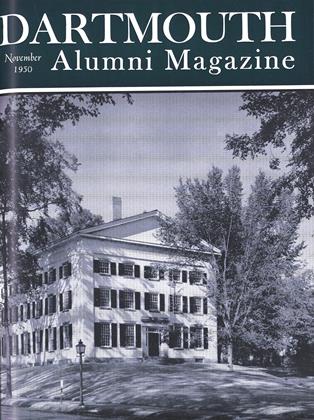The first Dartmouth casualty of the Korean war, so far as is known to the College, was Bob Sebilian '48, who was wounded August 17 in the Marine assault on Naktong Bridge. Following is his letter describing the assault and other Korean experiences:
"The Marines were called upon to assist in the Korean 'police action' and we who were stationed on the West Coast bundled all our belongings that would be necessary for fighting and subsistence and made a first-echelon dash across the Pacific to get into the war.
"The newspaper coverage is so accurate and complete—save for the strategic moves —that it leaves very little for individuals like myself to write.
"I was with the Ist Provisional Marine Brigade on that charge to Chinju in the southern sector. We were the first American unit to overrun Commie positions and soon realized that the Russians were the ones really behind the whole thing. My Russian language study at Dartmouth became quite handy as I read Russian charts, ammunition charges for various mortar and gun ranges, equipment markings—and propaganda magazines that they had brought with them, with pictures of Stalin, Molotov and Mao Tse-tung.
"Just as we were ready to assault Chinju —our Army needed help on two fronts. I was in the Marine unit that assaulted in the Naktong Bridge on the ridge that newsmen called later "No Name Ridge."
"Thirty feet from the top my platoon was caught in a terrific duel and among many of my platoon I was also hit.
"The thing that returned me to the States is a compound fracture of the femur and of course the hole that the small-arm explosive round made. This was on August 17. I arrived in the U. S. via the evacuation chain on Sept. 8. I've been entirely out of the cast I had and have been strung up in a traction bed until the bone will stand my body weight
"The most curious fact to me is how the Kremlin ever overlooked the necessity of air power, which would have really presented a problem. As it was, the 14 days I spent at the front I saw no enemy aircraft over us."
 View Full Issue
View Full Issue
More From This Issue
-
 Article
ArticleA Detective Story From the Far North
November 1950 By ELMER HARP JR -
 Class Notes
Class Notes1918
November 1950 By ERNEST H. EARLEY, DONALD L. BARR, DAVID L. GARRATT -
 Class Notes
Class Notes1905
November 1950 By GEORGE W. PUTNAM, GILBERT H. FALL -
 Article
ArticleConvocation Address
November 1950 -
 Class Notes
Class Notes1923
November 1950 By TRUMAN T. METZEL, COLIN C. STEWART 3RD -
 Article
ArticleAssociated School News
November 1950
Article
-
 Article
ArticleSOUTH FAYERWEATHER FIRE
February, 1910 -
 Article
ArticleAlumni Carnival
March 1933 -
 Article
ArticleDartmouth Men Aid Refugees
November 1949 -
 Article
ArticleAssistant Vice President
MARCH 1973 -
 Article
ArticleWintry Charm
February 1977 -
 Article
ArticleCleveland Dartmouth Club
APRIL 1932 By W. N. Jeavons '19, C. A. Calder '23, W. L. Christman '29, 1 more ...

